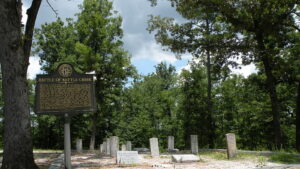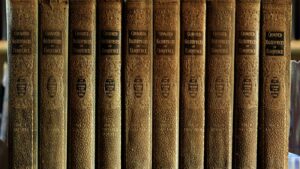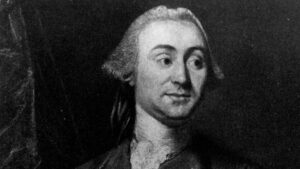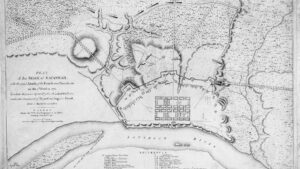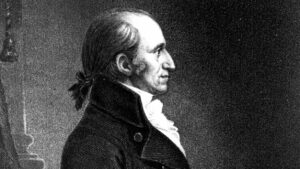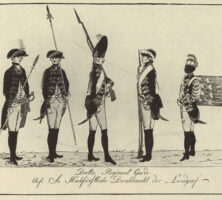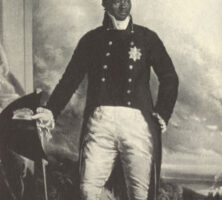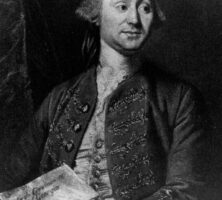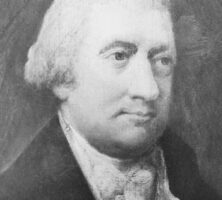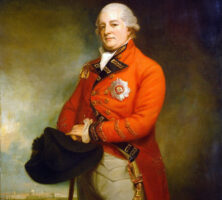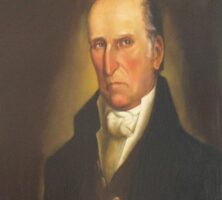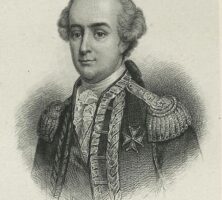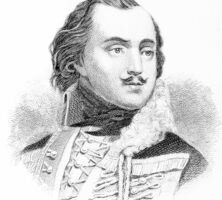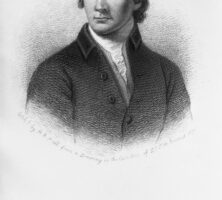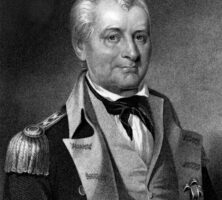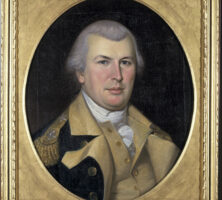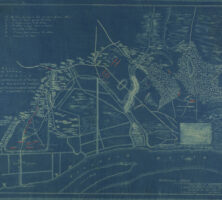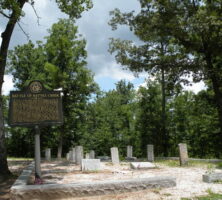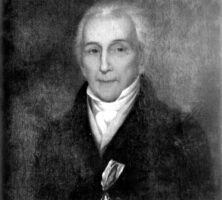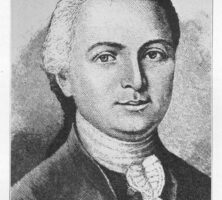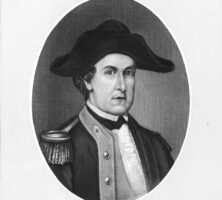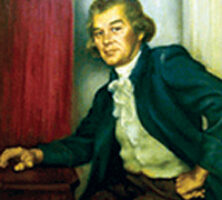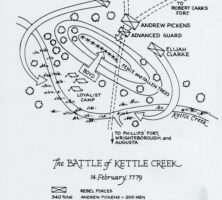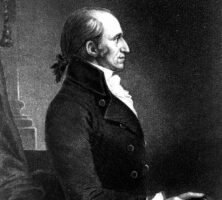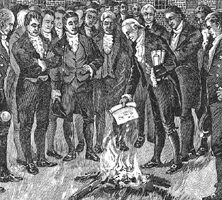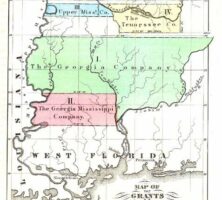The New Georgia Encyclopedia is supported by funding from A More Perfect Union, a special initiative of the National Endowment for the Humanities.
This drawing by a British officer details the failed attempt by American and French forces to recapture Savannah from British troops on October 9, 1779.
Courtesy of Hargrett Rare Book and Manuscript Library, University of Georgia Libraries, Rare Maps Collection.
The New Georgia Encyclopedia does not hold the copyright for this media resource and can neither grant nor deny permission to republish or reproduce the image online or in print. Requests for permission to publish or reproduce the resource should be submitted to the Hargrett Manuscript and Rare Book Library at the University of Georgia.
This depiction of the Hessian Third Guard Regiment was engraved by J. C. Muller after a drawing by J. H. Carl, circa 1784. American soldiers during the Revolutionary War occasionally fought against Black Georgians, recruited by the British and their allies in exchange for freedom. The active participation of these Black residents contributed to the British success during the Siege of Savannah.
From The Black Presence in the Era of the American Revolution, by S. K. and E. N. Kaplan
The New Georgia Encyclopedia does not hold the copyright for this media resource and can neither grant nor deny permission to republish or reproduce the image online or in print. All requests for permission to publish or reproduce the resource must be submitted to the rights holder.
Henri Christophe was a leader in the war for Haitian independence (1791-1804), and from 1807 to 1820 he served as the ruler of northern Haiti. Some historical sources credit him with serving in a French unit during the Siege of Savannah. Painting by Richard Evans, circa 1818.
From The Black Presence in the Era of the American Revolution, by S. Kaplan and E. N. Kaplan
The New Georgia Encyclopedia does not hold the copyright for this media resource and can neither grant nor deny permission to republish or reproduce the image online or in print. All requests for permission to publish or reproduce the resource must be submitted to the rights holder.
The New Georgia Encyclopedia does not hold the copyright for this media resource and can neither grant nor deny permission to republish or reproduce the image online or in print. All requests for permission to publish or reproduce the resource must be submitted to the rights holder.
James Wright replaced Henry Ellis as royal governor of Georgia in 1760 and proved to be an efficient and popular administrator. During his tenure in office (1760-76) Georgia enjoyed a period of remarkable growth.
Courtesy of Hargrett Rare Book and Manuscript Library, University of Georgia Libraries, Georgia Photo File.
The New Georgia Encyclopedia does not hold the copyright for this media resource and can neither grant nor deny permission to republish or reproduce the image online or in print. Requests for permission to publish or reproduce the resource should be submitted to the Hargrett Manuscript and Rare Book Library at the University of Georgia.
The New Georgia Encyclopedia does not hold the copyright for this media resource and can neither grant nor deny permission to republish or reproduce the image online or in print. All requests for permission to publish or reproduce the resource must be submitted to the rights holder.
John Houstoun served twice as the governor of Georgia, as well as the mayor of Savannah.
The New Georgia Encyclopedia does not hold the copyright for this media resource and can neither grant nor deny permission to republish or reproduce the image online or in print. Requests for permission to publish or reproduce the resource should be submitted to the Hargrett Manuscript and Rare Book Library at the University of Georgia.
Through his 1778 Georgia campaign, particularly his capture of Savannah and Augusta, Archibald Campbell achieved one of the few unqualified British successes in the American Revolution.
Image from Wikimedia
The New Georgia Encyclopedia does not hold the copyright for this media resource and can neither grant nor deny permission to republish or reproduce the image online or in print. All requests for permission to publish or reproduce the resource must be submitted to the rights holder.
Colonel Andrew Pickens led South Carolina and Georgia militiamen to victory at the Battle of Kettle Creek in 1779.
Photograph by Wikimedia
The New Georgia Encyclopedia does not hold the copyright for this media resource and can neither grant nor deny permission to republish or reproduce the image online or in print. All requests for permission to publish or reproduce the resource must be submitted to the rights holder.
Count Charles Henri d'Estaing, a French naval commander sympathetic to the American revolutionary cause, attempted to take Savannah from the British in 1779. His army was repulsed in one of the bloodiest battles of the Revolutionary War.
Image from Archives américaines, New-York
The New Georgia Encyclopedia does not hold the copyright for this media resource and can neither grant nor deny permission to republish or reproduce the image online or in print. All requests for permission to publish or reproduce the resource must be submitted to the rights holder.
Count Casimir Pulaski was one of Georgia's most notable military heroes during the Revolutionary War. A Polish nobleman, Pulaski was killed while leading an unsuccessful charge against the British during the 1779 Siege of Savannah.
Courtesy of Georgia Historical Society, Foltz Photography Studio (Savannah, Ga.), photographs, 1899-1960, #GHS 1360-25-13-14.
The New Georgia Encyclopedia does not hold the copyright for this media resource and can neither grant nor deny permission to republish or reproduce the image online or in print. All requests for permission to publish or reproduce the resource must be submitted to Georgia Historical Society.
Lyman Hall was one of three Georgians to sign the Declaration of Independence. He served as a representative to the Continental Congress and as governor of Georgia from 1783 to 1784.
The New Georgia Encyclopedia does not hold the copyright for this media resource and can neither grant nor deny permission to republish or reproduce the image online or in print. Requests for permission to publish or reproduce the resource should be submitted to the Hargrett Manuscript and Rare Book Library at the University of Georgia.
Lachlan McIntosh distinguished himself in a career that evolved over three critical eras in the state's early history, from the colonial period to the Revolutionary War to statehood.
The New Georgia Encyclopedia does not hold the copyright for this media resource and can neither grant nor deny permission to republish or reproduce the image online or in print. All requests for permission to publish or reproduce the resource must be submitted to the rights holder.
Nathanael Greene was one of the most respected generals of the Revolutionary War and a talented military strategist. As commander of the Southern Department of the Continental army, his leadership was the catalyst that turned the tide toward American victory in Georgia.
Courtesy of Independence National Historical Park
The New Georgia Encyclopedia does not hold the copyright for this media resource and can neither grant nor deny permission to republish or reproduce the image online or in print. All requests for permission to publish or reproduce the resource must be submitted to the rights holder.
The New Georgia Encyclopedia does not hold the copyright for this media resource and can neither grant nor deny permission to republish or reproduce the image online or in print. All requests for permission to publish or reproduce the resource must be submitted to the rights holder.
In December 1778, British troops under Lieutenant Colonel Archibald Campbell captured Savannah as part of their campaign to restore the colony of Georgia to British rule. This drawing details the town of Savannah at the time of the British invasion.
Courtesy of Hargrett Rare Book and Manuscript Library, University of Georgia Libraries, Rare Maps Collection.
The New Georgia Encyclopedia does not hold the copyright for this media resource and can neither grant nor deny permission to republish or reproduce the image online or in print. Requests for permission to publish or reproduce the resource should be submitted to the Hargrett Manuscript and Rare Book Library at the University of Georgia.
Revolutionary War veterans are buried in the Kettle Creek cemetery, which is maintained today by a local chapter of the Daughters of the American Revolution. The Battle of Kettle Creek, fought on February 14, 1779, prevented the British from invading upper Georgia.
Photograph by Chris Crookston, Wikimedia
The New Georgia Encyclopedia does not hold the copyright for this media resource and can neither grant nor deny permission to republish or reproduce the image online or in print. All requests for permission to publish or reproduce the resource must be submitted to the rights holder.
John Wereat served briefly as de facto governor of Georgia in 1779 and is best known for his attempt in 1795 to thwart the Yazoo land fraud, a corrupt deal between the state legislature and land speculators.
Courtesy of Georgia Historical Society, John Wereat letter to John Gibbons, #GHS 0854-AF-006.
The New Georgia Encyclopedia does not hold the copyright for this media resource and can neither grant nor deny permission to republish or reproduce the image online or in print. All requests for permission to publish or reproduce the resource must be submitted to Georgia Historical Society.
George Walton, one of three Georgians to sign the Declaration of Independence, served as governor of the state for two months in 1779. Following the Revolutionary War, Walton held another term as governor from 1789 to 1790, and also served as a U.S. senator and chief justice of Georgia.
From History of Georgia, edited by K. Coleman
The New Georgia Encyclopedia does not hold the copyright for this media resource and can neither grant nor deny permission to republish or reproduce the image online or in print. All requests for permission to publish or reproduce the resource must be submitted to the rights holder.
Elijah Clarke was among the few heroes of the Revolutionary War from Georgia. Even though he was wounded several times, Clarke led several successful frontier guerrilla campaigns against British soldiers and American Loyalists during the war. Clarke County is named for him.
The New Georgia Encyclopedia does not hold the copyright for this media resource and can neither grant nor deny permission to republish or reproduce the image online or in print. Requests for permission to publish or reproduce the resource should be submitted to the Hargrett Manuscript and Rare Book Library at the University of Georgia.
An honored Revolutionary War soldier turned politician, John Martin was governor of Georgia from 1782 to 1783. It was during his term of office that Georgia retook Savannah from the British and the Revolutionary War in Georgia came to an end.
Courtesy of Georgia Capitol Museum, University of Georgia Libraries
The New Georgia Encyclopedia does not hold the copyright for this media resource and can neither grant nor deny permission to republish or reproduce the image online or in print. All requests for permission to publish or reproduce the resource must be submitted to the rights holder.
On February 14, 1779, during the Revolutionary War, the Battle of Kettle Creek was fought in Wilkes County. Around 340 militiamen led by Elijah Clarke and John Dooly of Georgia, and Andrew Pickens of South Carolina attacked 600 American supporters of the British cause, led by James Boyd. Boyd was killed, and his men were forced to retreat across the creek.
From Georgians in the Revolution: At Kettle Creek and Burke County, by R. S. Davis Jr.
The New Georgia Encyclopedia does not hold the copyright for this media resource and can neither grant nor deny permission to republish or reproduce the image online or in print. All requests for permission to publish or reproduce the resource must be submitted to the rights holder.
The leading Jeffersonian Republican in post-Revolutionary Georgia, U.S. senator James Jackson resigned his seat and returned home to handle the Yazoo land fraud scandal in 1795. The following year he led a successful effort in the Georgia legislature to pass the Yazoo Rescinding Act, which nullified the corrupt land sales.
The New Georgia Encyclopedia does not hold the copyright for this media resource and can neither grant nor deny permission to republish or reproduce the image online or in print. Requests for permission to publish or reproduce the resource should be submitted to the Hargrett Manuscript and Rare Book Library at the University of Georgia.
James Jackson, a U.S. senator from Georgia, destroys records connected with the Yazoo land fraud in 1796, after the passage of the Yazoo Rescinding Act. Josiah Tattnall Sr., a state representative, helped Jackson secure the votes necessary in the legislature to pass the act.
From A History of Georgia for Use in Schools, by L. B. Evans
The New Georgia Encyclopedia does not hold the copyright for this media resource and can neither grant nor deny permission to republish or reproduce the image online or in print. All requests for permission to publish or reproduce the resource must be submitted to the rights holder.
In 1795 Georgia governor Georgia Mathews signed the Yazoo Act, which transferred 35 million acres of the state's western territory to four separate companies for a sum of $500,000. This lithograph, originally published in The American Gazetter (1797), shows the land purchased by each company in what is known today as the Yazoo land fraud.
Courtesy of Georgia Info, Digital Library of Georgia.
The New Georgia Encyclopedia does not hold the copyright for this media resource and can neither grant nor deny permission to republish or reproduce the image online or in print. Requests for permission to publish or reproduce the resource may need to be submitted to the Digital Library of Georgia.
